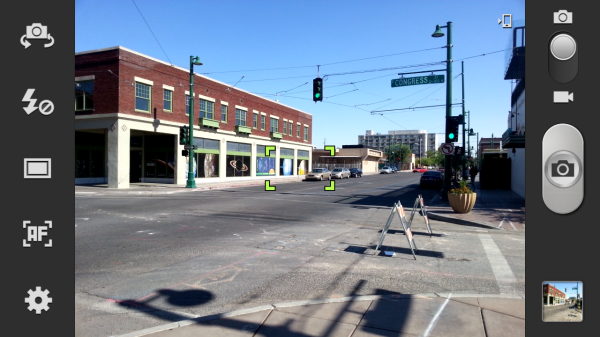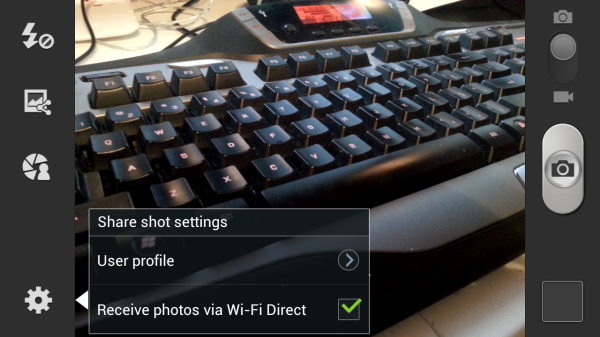Samsung Galaxy S III Review - AT&T and T-Mobile USA Variants
by Brian Klug on June 20, 2012 12:01 AM ESTSamsung didn’t emphasize camera performance very much during its launch event, which surprised me since HTC and Apple have both made steady improvements on the camera experience this generation. That said, the SGS3 does make some iterative improvements of its own in the camera department.
First off, the 8 MP rear facing camera sits behind F/2.6 optics with a relatively wide focal length of 3.7 mm. If you compare to the SGS2’s F/2.7 optics with 4.0 mm focal length, the SGS3 is a fair amount wider, and it’s noticeable when out and about shooting photos. From my digging, I’ve found that both my T-Mobile and AT&T SGS3s contain a S5C73M3 rear camera module - that looks like a Samsung CMOS name to me, but usually Samsung CMOSes start with S5K3 in the 8MP category. This is the same as the International version I’ve seen, though there’s still considerable debate about whether this is a Sony CMOS, but initial reports are that it isn’t the IMX145 from the iPhone 4S. I’ve also seen references to “CML0801” but that doesn’t mean anything to me immediately. Either way, the CMOS is 8 MP with 1.4µm pixels and BSI, images at full resolution are 3264 x 2448.
The front facing camera is a Samsung S5K6A3 CMOS which hasn’t been announced or made formal yet, and as a result I’m not sure about its pixel pitch or format. It is 1.9 MP and square - 1392x1392, which is relatively unique. I wager most users will just use 1280x960 and not know that the 1.9 MP option exists, though it is exposed in the camera UI.
Samsung has made some improvements to the camera UI, and though they’re subtle, they’re nonetheless worth talking about. The camera application does launch speedily, which was one of Samsung’s major points. As I mentioned, the shortcut from home screen (if you enable it) is handy if you don’t want to use up one of the application shortcut spaces.
For SGS2 users, the whole application should be familiar, settings is in the bottom left, and all the icons on the left pane can be changed or customized by long pressing. Tap to focus and expose is still here, and capture speed is nearly instantaneous, just like on the One series.
Shooting modes can be changed from single to burst shot, HDR, and a few other options. HDR combines three exposures like we’ve seen on other platforms, paints a progress bar while it computes (which happens impressively fast) and saves the resulting exposure. Probably one of the cooler shooting modes is share shot, which uses WiFi direct to share photos captured from linked SGS3s to each other. Tapping this brings up the WiFi direct pair prompt, and successive photos get put in a received folder on other devices.
To evaluate still image quality we turn to our usual set of tests, which means the lightbox scene with the lights on and off, and our bench photo locations (numbers 3 - 7 remain). I couldn’t get the test charts and lighting setup due to me moving houses while working on this review (everything is boxed up), but will update when that’s settled. For now we have a decent picture of the SGS3 camera performance, but something I would like to investigate more once I can setup my test charts. Consider the following more of a first impression than really my end thoughts on the SGS3 camera’s performance.
Immediately, you can tell that Samsung has tweaked their camera ISP and disabled the sharpening kernel which used to leave halos around contrasty spatial detail. There’s some loss of high frequency detail to noise reduction which is particularly evident in the lightbox camera’s focus rings and markings, but nothing too inordinate. White balance gives the scene a somewhat purple cast. I have to say that the One X image is sharper, but not by much.
With the lights off, the SGS3 does a great job exposing, and focuses with the scene lit up so it doesn’t miss focus entirely. This is still something I see so many other smartphone cameras not doing, and instead just capturing at infinity focus and hoping for the best. Kudos to Samsung for still doing it the right way.
At the bench location photos, I’m kind of left feeling the same way about the SGS3 camera at first glance. There’s nothing really wrong with it, and it seems to have less distortion (the test chart will tell the objective truth) but it just isn’t as sharp as some of the other cameras I’ve seen. Having a wider field of view is definitely something different, and it’s noticeable over the SGS2.












































107 Comments
View All Comments
themossie - Thursday, June 21, 2012 - link
You still see used Droid X (released 23 months ago) selling for $150 on Craigslist. Droid 2, released a month later, often sell for $125. Can recoup what you paid for them (contract prices) after 2 years? Not bad at all.I've made a pretty penny buying used phones cheap off Craigslist, using them, then flipping them 6-12 months for profit. Then you get events like the Windows Phone Challenge...
steven75 - Friday, June 22, 2012 - link
Just looked at ebay completed listings for Droid X. Average completed sale price is about $75.In comparison looked at iPhone 4 16 GB (released shortly after the X and the average completed sale price is about $250.
themossie - Saturday, June 23, 2012 - link
eBay prices are cheaper than Craigslist. iPhone 4 averages ~$300 here (to the extent I can tell from my Craigslist experience!)Certainly not saying Android phones hold the resale value of iPhones! But I can consistently recoup what I paid (on contract) for the device.
zorxd - Thursday, June 21, 2012 - link
I agree. Who cares about how it "feels" anyway? I buy phones for their functionality, not their look.Also as you said, plastic is light and shock absorbant. Also it doesn't block RF. Seems like the perfect material for a phone. I honestly which we had less metal and glass and more plastic in phones.
shaolin95 - Wednesday, June 20, 2012 - link
Comments like this make me wonder if people think phones are supposed to be used as hockey pucks....come on now.ProPhotoman - Tuesday, July 3, 2012 - link
No one wanted a 1 pound phone , so they used plastic to keep the weight down. They know that most will put a case on it anyway.metafor - Wednesday, June 20, 2012 - link
Battery life seems to lag behind the One X. Which is disappointing considering LTE will only make it worse. But since -- unlike HTC -- Samsung launched this on both T-Mobile and Verizon, that makes it the go-to phone for those who don't want to jump on AT&T.Impulses - Wednesday, June 20, 2012 - link
HTC really dropped the ball in not getting a decent One variant on VZW. The new Incredible's kind of a joke...Impulses - Wednesday, June 20, 2012 - link
Meh, they they're not too far behind either... I agree the numbers are slightly disappointing considering it has a larger battery, but it's also a removable battery which makes it a wash IMO. The Wifi vs 3G results are interesting, I thought one of the biggest highlights of AMOLED was how it could potentially save a lot of power over LCDs... I guess that doesn't really pan out unless you visit a lot of sites with black backgrounds tho. :pThe EVO LTE results are wild tho, they're all over the place (which is why it'd be really nice to have at least one CDMA SGS3 variant reviewed). If you were to look at the 3G results only you'd conclude the CDMA stack is just a battery hog, but then it still trails the US One X (which has a smaller battery) on the Wifi test while demolishing it (and almost everything else) in the hotspot test. Doesn't make any sense!
Same SoC & display as the One X (AFAIK), any theories?
metafor - Wednesday, June 20, 2012 - link
A few. The CDMA and WiFi datapath could be far less power hungry than the HSPA+ to WiFi. In fact, it may even be a different WiFi module altogether. Hell, even something unnoticeable -- like signal strength of the WiFi/CDMA antenna and whether they interfere with each or not -- can make a big difference as the radios have to work harder to get a good signal.Stuff like this is hard to design, debug and quantify, especially when multiple radio interfaces are at work.